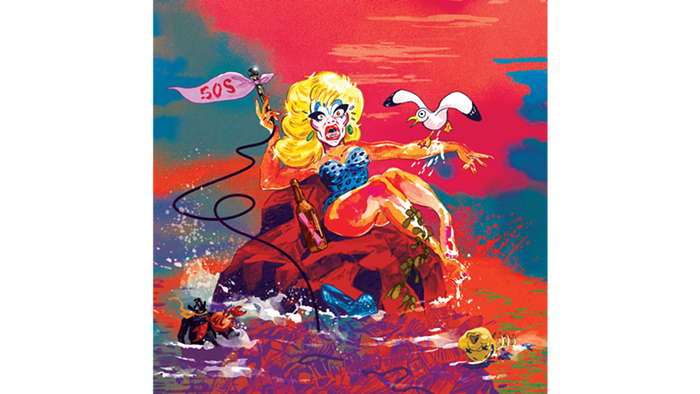You’re no geography expert, but you probably have a basic idea of where nations and continents are positioned on a globe, right? But it wasn’t that long ago when people who drew maps only had the vaguest idea of what our planet actually looks like. European and American maps from before the 1800s only sort of resemble Earth. Sure, some of the larger blobs look okay... Europe usually looks Europe-y, and Africa has a somewhat reliable shape. Asia is... well, mostly there. It tends to fade away as you go eastward.
But there’s something consistently missing from these old-timey maps: Oregon. Our particular patch of geography, along with Washington, British Columbia, Alaska, and everything else in the Pacific Northwest was one of the most consistently misrepresented parts of atlases before the 1800s. Instead of where Oregon should be, mapmakers made their best guesses, adding a bunch of fantasy stuff, along with the occasional imaginary waterway and non-existent path to China. Here’s what a lot of dead guys with sextants (wrongly) assumed was going on in the Pacific Northwest.
Welcome to the Island of California
Before the West Coast was accurately rendered, it wasn’t portrayed as a coast at all. Instead, many maps abruptly ended somewhere in what we now call the Midwestern prairies. Sometimes the area known as Oregon, Washington, and California was floating just west of the rest of North America as a Greenland-sized island that was almost a continent of its own. And on other maps, we were actually under water, drowning in a great inland sea.

“In terms of other notable mythical features of Northwest North America, my favorite is ‘The Sea of the West,’” says Edward Brooke-Hitching, author of The Phantom Atlas, a collection of geographical places that were thought to exist but didn’t. “[The sea] was largely based on the report of Juan de Fuca, who was said to have journeyed up a vast strait at the northernmost point of America’s West Coast, around which he enjoyed ‘sayling therein more than twenty days.’”
Brooke-Hitching says that, based on this small scrap of narrative, later mapmakers wrongly added in a large body of water that, if it were real, would’ve submerged modern residents of Oregon, Washington, Idaho, California, and British Columbia.
“A giant sea was drawn taking up the western half of North America to fit [Juan de Fuca’s] information,” he says, “and the myth grew from there.”
In addition, for centuries California was illustrated as a massive island broken off from the West Coast, with Oregon and Washington either absent or part of that separated landmass. From the 1620s until the 1700s, the West Coast wasn’t a coast at all, but rather its own micro continent.
Jeff Smith is the curator of the Columbia River Maritime Museum, where the exhibit Mapping the Pacific Coast: Coronado to Lewis and Clark showcases this often erroneous history of how the Pacific Northwest was portrayed. Plenty of maps Smith has on display show the West Coast as completely separate from the rest of country—which is probably how many modern-day Republicans would prefer it. According to Smith, Spaniards assumed that the Baja California peninsula in western Mexico was an island, and mapmakers drew it far larger than it actually was.
“When the [Spanish] Jesuits came into the area,” Smith says, “a lot of them traveled from mission to mission and either didn’t go far enough, or [went] in a direction that would’ve given them the understanding that it wasn’t an island.”

The Dire “Strait of Anián”
For a lot of Europeans, the very existence of North America was a setback, as it rather inconveniently blocked their path to Asia.
“[Early explorers] were looking for another route to the Spice Islands and [other] trade locations,” Smith says. “So they were surprised and dismayed to find a large landmass in their way. They started seeking a route around and through it, which gave rise to the ideas of the Northwest Passage and the Strait of Anián.”
The Strait of Anián was a common feature on early maps of North America. It was a thin waterway separating the West Coast from Asia, making would-be Oregon seem like only a quick day’s journey from eastern Asia.
“[These explorers] assumed they were in the world Marco Polo had been describing,” says Smith, “when in fact they were a few thousand miles off.”
“The name Anián is thought to have originated from the 13th-century stories of Marco Polo,” Brooke-Hitching says. “[Polo] mentions a gulf that ‘extends to a distance of two months.’”
However, Brooke-Hitching believes that Polo’s Anián actually refers to the Gulf of Tonkin near modern-day Vietnam.
“It’s easy to understand how cartographers grabbed the name Ania to fit reports of a strait in the general vicinity,” he says.
Unfortunately for these explorers, instead of a small patch of water separating North America and Asia, the Pacific Ocean was in the way. That didn’t prevent cartographers from collapsing the distance.
“A lot of the maps show Japan a lot closer,” says Smith, who adds that in some cases, Japan and the Hawaiian Islands were mistaken for each other.
Just Passing Through
Getting to Asia via North America remained a major goal of Europeans into the 1800s. British explorers and early imperialists imagined a way up and over what’s now Canada and Alaska. They hoped for perhaps some large river that was navigable all the way through North America, something that would conveniently allow a boat to sail from the Atlantic coast to the Pacific and then eastward. They called this hoped-for route the Northwest Passage.
“The Northwest Passage is an imagined route to Asia... imagined mostly by Northern Europeans,” says Shane McCorristine, a lecturer in modern British history at Newcastle University and author of The Spectral Arctic: A History of Dreams and Ghosts in Polar Exploration. “The Netherlands and the early British Empire fantasized about a shortcut to the riches of the Indies. The reason they looked north and not south is because they wanted to avoid the Spanish and Portuguese.”

According to McCorristine, speculation about how to get to Asia via the west started before Europeans even knew that the Americas existed.
“Just before the discovery of the Americas by Europeans,” says McCorristine, “you can start to see people imagine what’s in the northern corner.”
An early advocate for exploring the Northwest Passage was John Dee, whom McCorristine describes as “a magician, politician, [and] an imperialist ideologue.” Dee collected maps, talked to sailors and merchants, and had the ear of Queen Elizabeth. According to McCorristine, he especially advocated for a Protestant naval power that would act as a counterbalance to Catholic Spain and Portugal, and Dee suggested that their incipient Protestant empire should look north.
McCorristine is quick to emphasize that all this speculation about what was on the other side of North America didn’t just result in a lot of old, wrong-looking maps. It had real consequences.
Martin Frobisher was another early advocate for British exploration of a Northwest Passage. He went on three different voyages to find the Passage, and McCorristine notes, “They were all pretty much disasters [because he didn’t find it], but they’re the first major interactions between Europeans and Inuit that we know of.”
Sailing into the blank part of a map to look for an imaginary waterway to Asia got complicated when British explorers encountered real, actual people, in the form of Native Americans.
“Frobisher’s encounters were disturbing and frequently violent,” says McCorristine, “and they’re still part of Inuit oral testimony.... You [had] these giant ships purely occupied by men, which was weird to see. When [the Inuit] saw a ship that was occupied only by men, they assumed it was a raiding party, so there was already implicit violence in their arrival.”
According to McCorristine, Frobisher’s men ended up kidnapping several Inuits who later died, most likely of disease, after being taken back to England.
The Maybe Mythical Juan de Fuca
Just because the Strait of Anián and the Northwest Passage didn’t exist, it didn’t stop Europeans from claiming they’d found them. One explorer who was said to have seen the Strait of Anián with his own eyes now lends his name to the waters between British Columbia and Washington. Juan de Fuca was, supposedly, a Greek sailor who ended up successfully finding what so many had looked for.

And it’s possible that he never existed.
Brooke-Hitching notes there’s only one source for de Fuca’s voyages on the West Coast. An Englishman named Michael Lok supposedly met the explorer in Venice and wrote down his account of finding the Strait of Anián.
“If he was fictitious,” says Brooke-Hitching, “there are curiously accurate elements to his geography. In 1787, a fur trader named Charles William Barkley discovered a strait [now called the Strait of Juan de Fuca] on the West Coast of North America at Cape Flattery.” According to Brooke-Hitching, that trader recognized a rocky pillar off the coast of what’s now Washington state that reminded him of something he’d read about in de Fuca’s narrative. Today we know that rock formation as De Fuca Pillar.
Mythical or not, de Fuca’s supposed discoveries helped stoke interest in the Strait of Anián and the Northwest Passage, leading the West Coast to finally be charted with some degree of accuracy. And it got de Fuca’s name on a Pacific Northwest waterway.
The End of the Blank Map
By the end of the 1800s, people started getting a clearer picture of what the Pacific coast actually looked like.
“The maps that Lewis and Clark had access to were, by that point, pretty well established in terms of distance,” he says, “but they didn’t anticipate [the Rocky Mountains and Cascades]. That came as a surprise... and was a bit of a setback in terms of their psychological understanding of the area.”
Smith also notes that, unlike the Europeans, the native population of North America had no illusions about their home.
“[The Chinook] seemed to have a fairly clear understanding of the vastness of the [Pacific Northwest],” he says. “They were trading with people hundreds of miles beyond their geographic center.... I don’t think they had any illusions that they were in a small space.”
Eventually, after centuries of speculation, exploration, and colonization, European and American powers also got what they’d been searching for: a way to trade with Asia. However, that relationship didn’t come about because someone found a convenient North American waterway. Instead, it was due to technology. According to McCorristine, steamships made international trade possible, not imagined shortcuts or mythical straits described by Marco Polo.
“With steamships and increasing global connections, the justifications for trying to create a shortcut between northern Europe and Asia just isn’t there anymore,” says McCorristine. “It’s simply too expensive to try to find this passage through the ice.”
He also notes that, eventually, boats did improve enough to navigate through the dangerous northern ice, but....
“By the time a Northwest Passage is completed, it’s almost like an empty discovery,” McCorristine says. “It’s not a route that ships could regularly go through, and in the meantime, Canada has developed as a nation.”

While maps depicting features like the Strait of Anián and the Island of California look like something out of a fantasy novel to the modern map reader, the fantasies they depicted were those of imperial powers grasping for a world they did not understand. Explorers like Frobisher set out to find landmarks on the imaginary landscape, and instead found their hopes dashed on the rocks of real geography.
The Columbia River Maritime Museum is located at 1729 Marine Drive, Astoria, OR. Their 16-year exhibit, Mapping the Pacific Coast: From Coronado to Lewis and Clark, ends this winter.












